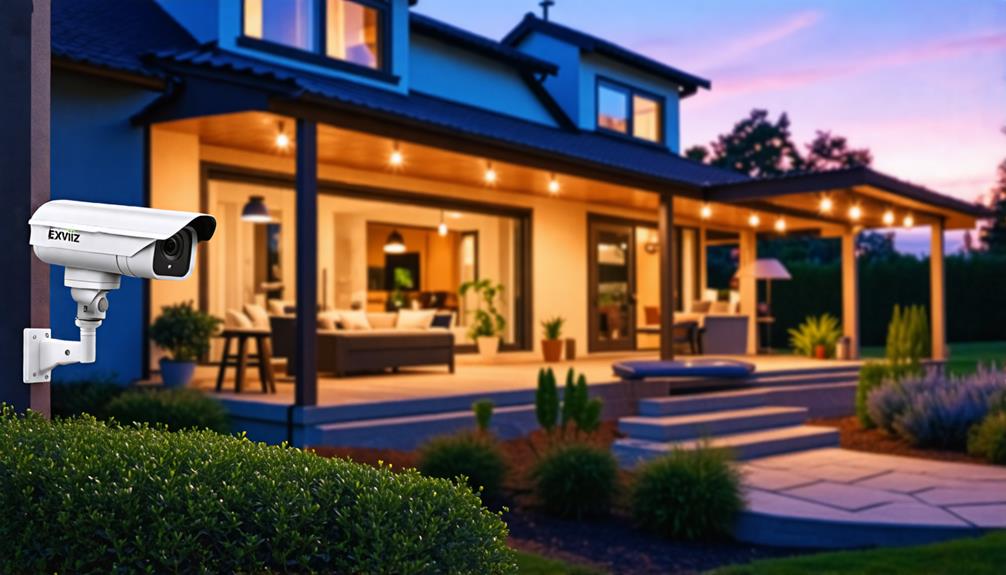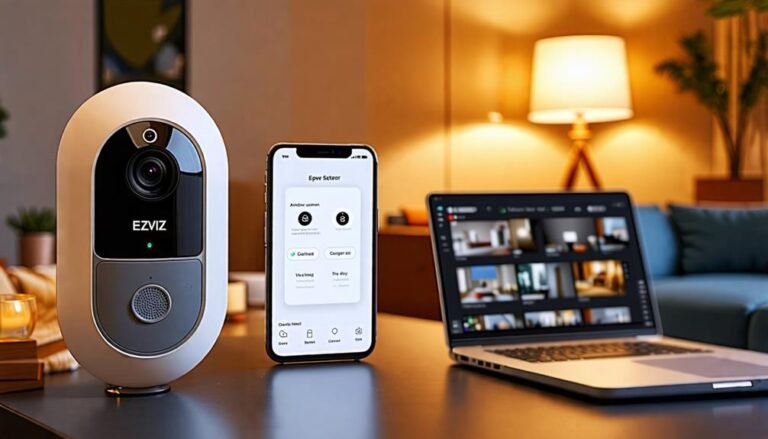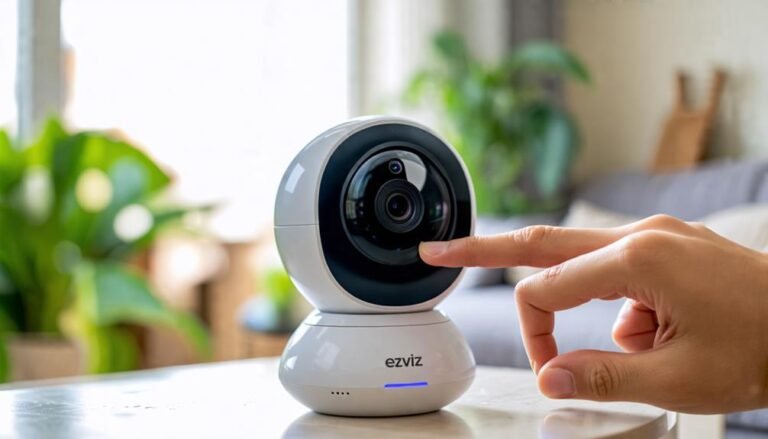You can connect up to 64 Ezviz cameras, but the exact number really depends on your specific model and your network's capabilities. It's important to assess your property's layout and your monitoring needs. Having too many cameras can overload your system, leading to lag and connectivity issues. Make sure your network can handle the bandwidth each camera requires, which varies by model. Also, consider your power supply and overall infrastructure. If you're looking to set up the best configuration for your situation, keep going to discover more tips for ideal camera placement and connection.
Understanding Ezviz Camera Limits
When evaluating your home's security, understanding Ezviz camera limits is important. You want to guarantee that you're making the most of your surveillance setup without running into issues. Each Ezviz camera you add can help create an extensive view of your property, but it's vital to know how many you can effectively manage and connect.
The number of cameras you can use often depends on the specific model and the storage solutions you choose. Most Ezviz systems allow for a specific number of cameras to be connected to a single NVR (Network Video Recorder) or cloud account. This means you'll need to assess your monitoring needs and the layout of your home. By maximizing camera placement, you can cover blind spots while still staying within the limits of your chosen system.
Don't forget about the bandwidth available in your network, either. If you overload your system with too many cameras, you might experience lagging or connectivity issues, which can compromise your security.
Ultimately, knowing the limits of your Ezviz camera system empowers you to create a security solution tailored to your needs and lifestyle. Freedom comes from knowing you've got the right coverage without overextending your resources. By carefully planning your setup and understanding these limitations, you can maintain both security and flexibility in your home.
Factors Affecting Camera Capacity
Several factors can influence the number of Ezviz cameras you can effectively use in your security setup. First and foremost, consider the capabilities of your network. A stable and robust Wi-Fi connection is essential for transmitting data from multiple cameras without lag. If your network isn't strong enough, adding more cameras could lead to performance issues, which defeats the purpose of enhancing your security.
Next, think about the storage solutions you have in place. Each camera generates a significant amount of footage, so you'll need adequate storage capacity to manage this data. Whether you opt for cloud storage or local storage, the limits of your chosen system will dictate how many cameras you can realistically support.
Additionally, the power supply is another critical factor. If you're using wired cameras, verify you have enough outlets and that your wiring can handle the load. For wireless cameras, consider battery life and the ease of recharging or replacing batteries.
Recommended Camera Configurations
Understanding the factors that affect camera capacity is crucial for setting up an effective security system. When it comes to configuring your Ezviz cameras, you'll want to strike a balance between coverage and performance. Here are some recommended camera configurations to ponder that allow for flexibility and freedom in your security setup:
- Entry Points: Place cameras at all main entry points like doors and windows. This guarantees you capture any potential intrusions while maintaining clear visibility.
- High-Traffic Areas: Install cameras in high-traffic areas of your property, such as hallways or living rooms. This assists you in monitoring movement and identifying any unusual activity.
- Outdoor Surveillance: For outdoor security, use weather-resistant cameras that cover your yard or driveway. This provides a thorough view of your property's perimeter and deters unwanted visitors.
- Blind Spots: Identify and cover any blind spots that may not be visible from your primary cameras. Adding extra cameras to these areas enhances your security coverage.
Network Considerations for Cameras
The number of Ezviz cameras you can effectively utilize hinges largely on your network capacity. It's important to recognize that each camera requires bandwidth to stream video and send data. If your network can't handle the load, you're going to run into issues—like lag, dropped connections, and poor video quality. So, before you start adding cameras, assess your existing infrastructure.
First, consider your internet speed. A solid upload speed is vital because that's what gets your camera feeds out to the cloud or your devices. A good rule of thumb is to have at least 1 Mbps upload speed per camera for standard quality. If you're looking for high-definition feeds, aim for 3-5 Mbps per camera. Multiply that by the number of cameras you plan to install, and you'll see if your internet can keep up.
Next, think about your router. Is it robust enough to handle multiple devices? If you've got several smart devices already connected, you might need to upgrade to a more powerful model. A dual-band or tri-band router can help manage the load more effectively.
Lastly, don't forget about the potential for interference. Walls, appliances, and other electronics can disrupt your Wi-Fi signal. Position your cameras strategically and consider using mesh networks if you have a larger area to cover. By ensuring your network's up to the task, you'll enjoy the freedom and flexibility of a well-functioning camera system.
Tips for Optimal Camera Setup
When setting up your Ezviz cameras, timing can play a crucial role in achieving the best results. You want to guarantee that you're capturing the moments that matter most, so here are some tips to optimize your camera setup and enhance your peace of mind.
- Choose the Right Locations: Position your cameras where they can cover the most ground. Entry points, driveways, and common areas are prime spots. Make sure they're out of reach to prevent tampering.
- Adjust the Angle: It's not just about where you place your camera, but how you angle it. Tilt the lens slightly downwards to capture faces and license plates clearly, while avoiding glare from sunlight.
- Consider Lighting Conditions: Install cameras in areas with adequate lighting. If it's dark, consider using cameras with night vision capabilities. Avoid placing cameras directly facing bright lights, which can wash out the image.
- Test Connectivity: Before finalizing your setup, test the camera's connectivity. Confirm you have a strong Wi-Fi signal in each location so you can access your footage without interruptions.
Frequently Asked Questions
Can I Mix Different Ezviz Camera Models in One System?
Absolutely, you can mix different Ezviz camera models in one system! This flexibility lets you customize your security setup based on your unique needs. Whether you want indoor, outdoor, or specialty cameras, they'll all work together seamlessly. Just make sure your central hub or app supports the models you choose. You've got the freedom to create an all-encompassing surveillance solution that fits your lifestyle and preferences without being limited to one type of camera.
Will Adding More Cameras Slow Down My Network Speed?
Think of your network as a bustling highway. Adding more cameras can create traffic, but it doesn't have to stall your speed. If your bandwidth can handle it, you won't notice much difference. However, if your network's already crowded, those extra cameras might slow things down. To maintain that freedom of smooth operation, make certain your router's up to the task and consider upgrading your internet plan if necessary.
Are There Any Subscription Fees for Using Multiple Cameras?
When it comes to using multiple cameras, you might wonder if there are any subscription fees involved. Generally, Ezviz doesn't charge for basic functionality, but some features or cloud storage options may require a subscription. It's worth checking the specific plans offered, as they can vary. Ultimately, you can enjoy the freedom of monitoring your space without worrying about hidden costs, as long as you choose the right options for your needs.
How Can I Monitor All Cameras From a Single App?
To monitor all your Ezviz cameras from a single app, you'll want to download the Ezviz app on your smartphone or tablet. Once you've set up each camera, you can easily add them to your account. The app lets you view live feeds, receive alerts, and manage settings all in one place. It's designed for your convenience, giving you the freedom to keep an eye on things from anywhere. Enjoy that peace of mind!
What Happens if I Exceed the Camera Limit?
If you exceed the camera limit, you might run into issues like not being able to add new cameras or losing access to some features. It's frustrating, I know, especially when you want full control over your security setup. You may also find that the app struggles to manage all connected devices, leading to lag or disconnections. To avoid this, keep an eye on your camera count and upgrade if needed.



